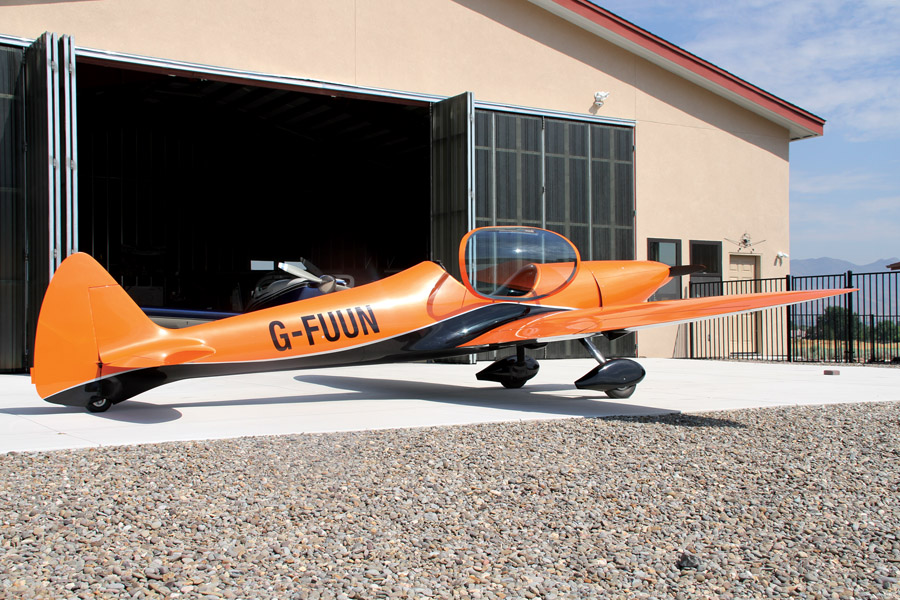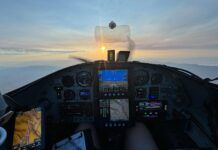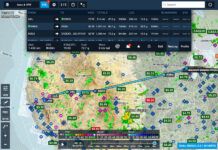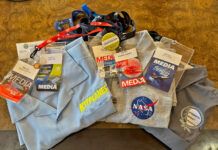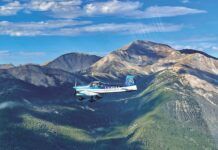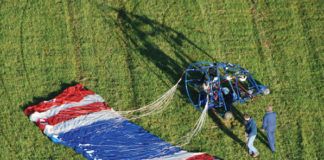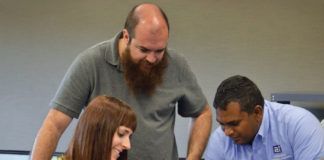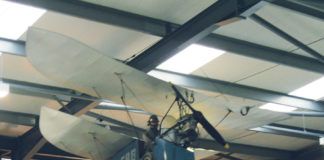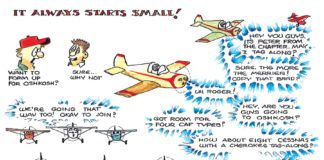
Featured on our June 2005 cover, the Spitfire-esque silhouette of the Silence Twister makes it memorable, but with only two flying in the U.S., it’s still a rare sight on this side of the pond. Sufficiently nimble for polite aerobatics and just stable enough to fly far over the horizon, the Twister is an all-around companion for the solo pilot. Thirty-three kits have been sold worldwide; 25 are currently flying.
So, why does the Silence Twister cross the Atlantic? To get to the other side, of course. And that’s just the point to Andy McKee’s story. Unlike Alcock and Brown, Andy built his Twister and flew it from England to North America and back again because he wanted to make the builder-goes-to-Oshkosh pilgrimage and peep North America. Having to cross ice water was just a collateral spot of bother.
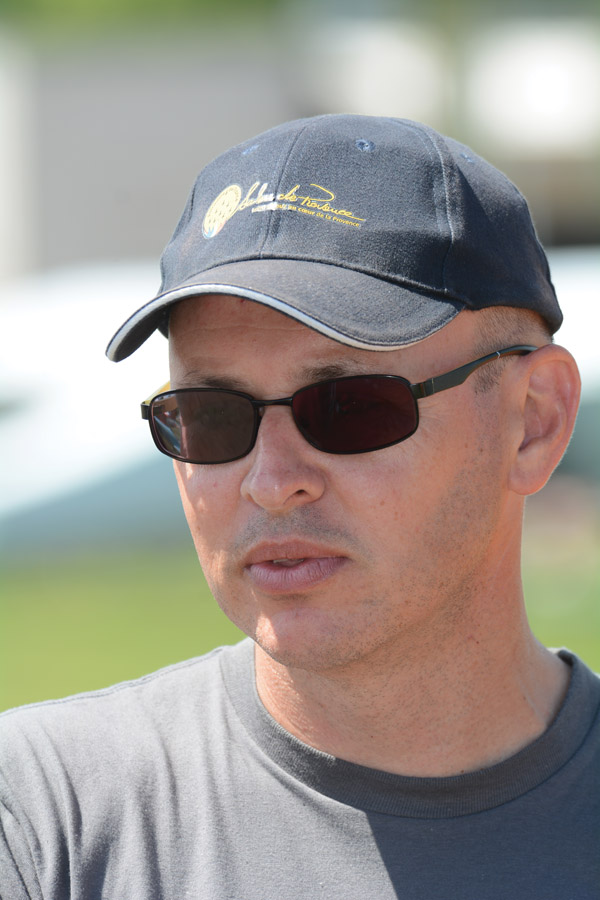
Andy McKee’s wickedly dry sense of humor and adventurousness camouflage his inner seriousness. His long-distance flights over the North Atlantic Ocean and escapeless Canadian forests were very carefully calculated and well planned for risks. In the end nothing went wrong, no doubt partially because of so much attention to detail.
And after meeting with Andy at AirVenture last summer, it soon became apparent that long flights over challenging terrain were in some ways just another notable node in an orbit filled with restless travel and motor-fueled ennui hunting-killing.
New Zealand, England, and the World
“A keen petrol head,” by avocation and a graphic designer when it pays, Andy was born in New Zealand to an English mother and Kiwi father, but has mainly lived in England most of his 46 years. “Dad was a private pilot with 3000 hours…[and] had been flying for 50 years. So I was brainwashed by birth and grew up around aviation and flying.” Naturally Andy started in power flying, but after the initial excitement, the “What now?” doldrums set in, thanks to renting the usual tin dreadfuls and paying fearful prices for the privilege.
Andy’s father was a glider pilot, so Andy went engineless for five years, and the sport did seem to consume him. Mentions of soaring in Minden, Nevada, and getting his Diamond badge via an overachieving 26,000-foot ride gave us that impression. But, as Andy points out, “There are not many good gliding days in the U.K., so a glider sitting around doing nothing is pretty common. There may be only three or four good soaring days in England during the summer, and if you were at work, you missed it for the year.”
So Andy bought a RANS S-10 and flew that, but found it “barely capable of aerobatics…a few cross-countries, but not made for that, either.” Like many before him, Andy had reached his aviation limit because of what was available to him. If he were to continue, it was going to take something out of the ordinary.
Learning to Twist
On the right side of the Atlantic the AERO Friedrichshafen aviation show is where it’s at for light to medium aviation. “First time I was there for four days and still didn’t see it all,” is how Andy put it. But in 2009 he found the Silence Twister display, “sat in it and set my fate.” Liking the promise of aerobatic and cross-country flight wrapped up in a light and personal package, Andy bought his Twister kit in 2011. “It was a big investment, a real financial commitment, so I saved up.” It helped that, “costs [were] spread out over the five and a half years of building.” And as many a dedicated builder has discovered, pouring all your money into an airplane means “No holidays. I didn’t go do the things you would do without the airplane.
“People always ask how much. What I tell them is for what I sold the RANS S-10 is what I spent on the instrument panel on this one.”
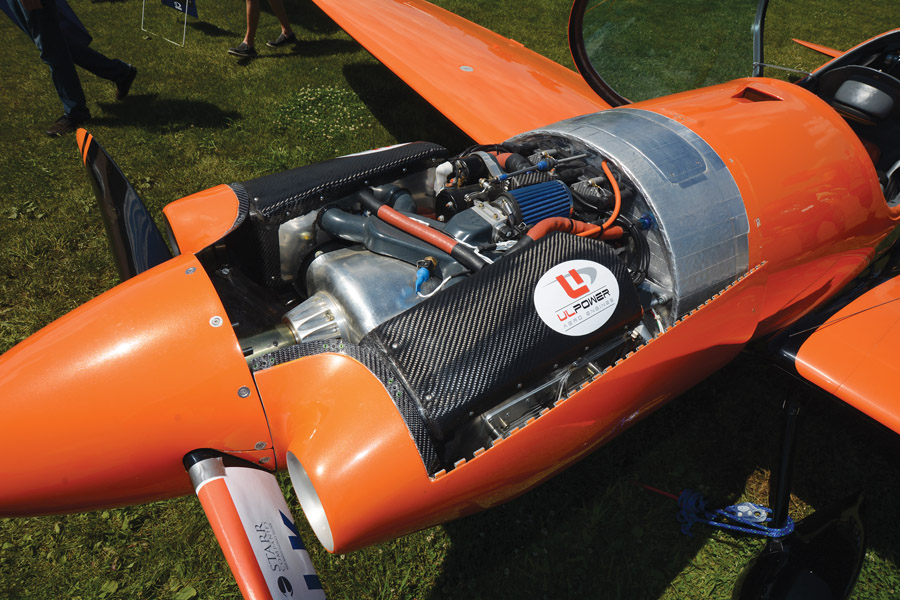
Looking for reliability in a compact form, Andy opted for ULPower’s UL260iSA 4-cylinder. The aerobatic engine boasts fuel injection and raised compression to make 107 hp from just 2.6-liters (159 cubic inches). The carbon fiber plenum cooling is Andy’s own work. As for expense, the ULPower mill cost about $20,000 in round numbers, or “Certainly not as expensive as the iS version of the Rotax.”
Also like other builders, Andy soon discovered the reality of the kit he had bought into. A product of the composite revolution, the Twister was designed by two German brothers, Thomas and Matthias Strieker. Originally they were deep into composite RC model aircraft, developing an RC Twister that must have performed well and obviously looked good. People joked they should “build a real one, and 10,000 hours later, they had the prototype and some kits,” explained Andy. In 2002 the Strieker brothers founded Silence Aircraft GmbH and put the Twister into very low-volume production. Actually, this was just part of the Striekers’ industrial composite firm, as their expertise is in building molds and honeycomb sandwich structures for industry, automotive, marine, and aerospace fields. Thus, the Twister kit remains a high-interest sideline to their industrial production.
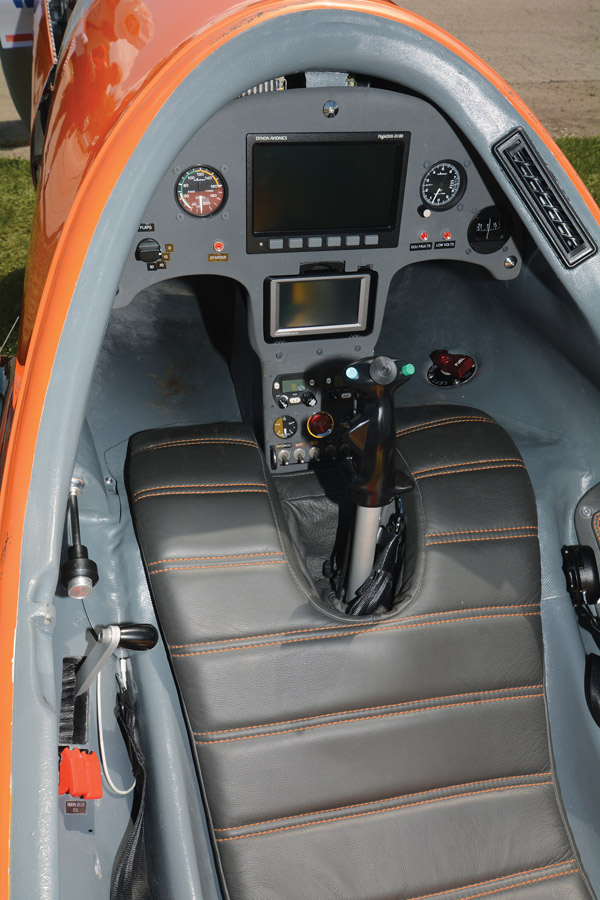
Minimal instrumentation corrals the weight spiral and puts maximum emphasis on the Dynon FlightDEK-D180 display. It’s flanked by backup airspeed and altimeter instruments. The rotary dial at left is the flap selector, and the backup compass is at right. The red button seen forward of the stick is the engine start switch, made possible by the electronic ignition and fuel injection systems.
To Andy, this manifested itself as an extra building challenge. “It’s a very low-volume kit; nothing fits too well. This is kit number 28 in the world…the manual is being translated into English from German by the Germans. Dimensions don’t match in places, so you have to sort that out. Parts were sometimes missing…sometimes instructions weren’t complete.” Thankfully Andy kept a detailed blog during his Twister’s construction; it is a valuable resource to anyone building a Twister today.
Another obstacle for Andy was where to build. His first move was to London and a mews house—an old, small, in-town accommodation above a stable, which had been converted into a single-car garage. He outfitted it with carpet, heater, and insulation, so even in the damp English winters, it was toasty warm. “It’s important to have a good environment,” Andy observed dryly as we sat sweating in the humid AirVenture afternoon.
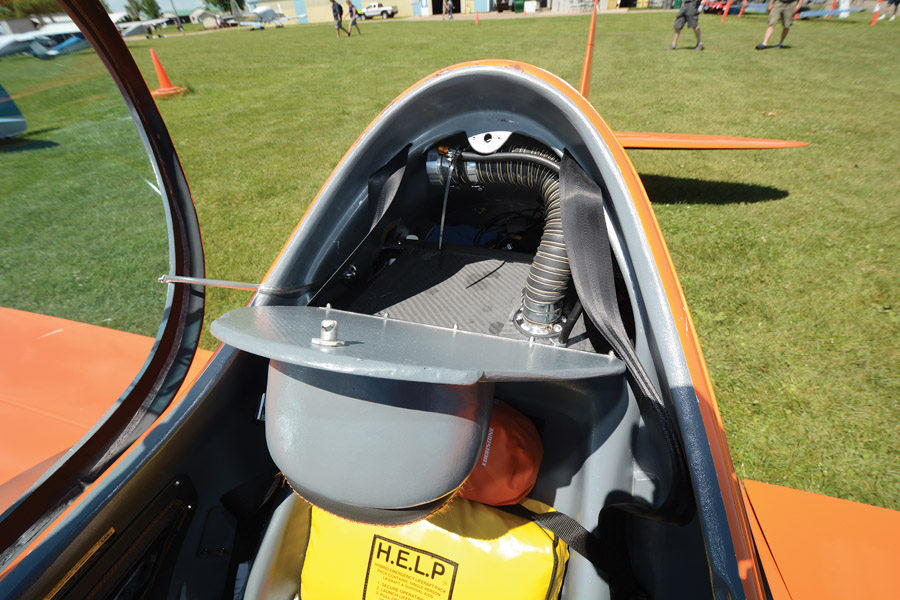
Even with the custom 6-gallon “headrest” tank, there’s still storage room in the turtle deck. Only the top of the tank is visible here; it forms the headrest storage area floor. Fuel in this tank gravity flows to the left main tank, leading to a notably aft CG until this aft-most tank is emptied.
Comfy or not, the narrow and small garage barely fit a car and required careful measuring before Andy towed a trailer to Germany to transport the kit home. The fuselage, with no rudder and no components firewall-forward, barely cleared the garage door by a scant 10mm (.3937 inch).
Addressing the obvious, Andy noted, “The negative is you can’t do all the work in there. You can do the wings and tail as they pull off. You can work on the wings individually and same with the tail group.” But working room was submarine-like, and final assembly was out of the question.
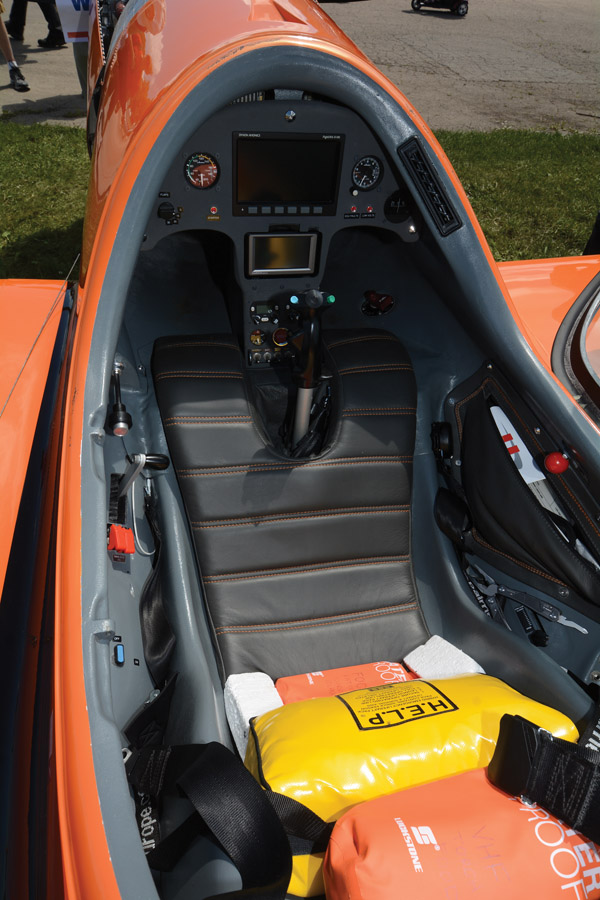
Seen at AirVenture last summer with emergency equipment displayed on the seat back, the Twister’s cockpit is obviously a cozy perch for long-distance touring. The single-piece, reclined seat with two layers of memory foam is built for Andy, and nothing in the cockpit is much of a reach.
Thus, once the big pieces were finished, Andy moved north of London to Biggleswade, Bedfordshire, where he engaged a double-car garage and house. During the walk-through the real estate agent asked Andy if he wanted to see the bathroom. “No, just the garage,” he answered in true builder’s fashion. Turns out the previous renter built model airplanes in the garage, so the Twister ultimately came together in an ironic setting.
Time building started with the deposit in April 2011, followed by picking up the kit in August 2011. Construction began a month later, and the first flight was in December 2016. Call it five and half years, including the two months spent putting the mews house garage together.
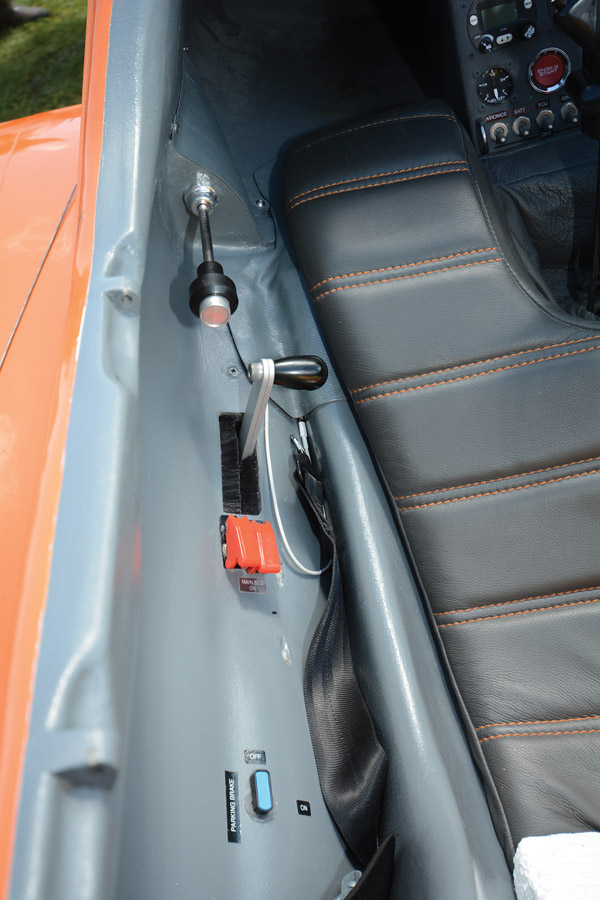
The vernier control on the cockpit’s left side is for elevator trim. Twin red power bus toggles are aft of the throttle, and the teal handle is for the parking brake.
The Twister
Given its honeycomb construction with Kevlar lining, the Twister kit’s major pieces come assembled, but definitely need finish attention, and in a few spots final manufacturing for things such as root ribs. Past that, the main tasks are choosing an engine, running systems, and figuring out the instructions.
Engine choice seems somewhat up to the builder. The prototype Twister actually received a twin-rotor Wankel. Jabirus were specified for the production kits, yet Andy opted for a 2.6-liter, 107-hp ULPower UL260iSA. That’s the fuel-injected, higher-compression, aerobatic version of the Belgian-built, air-cooled, 4-cylinder, and it has served him well.
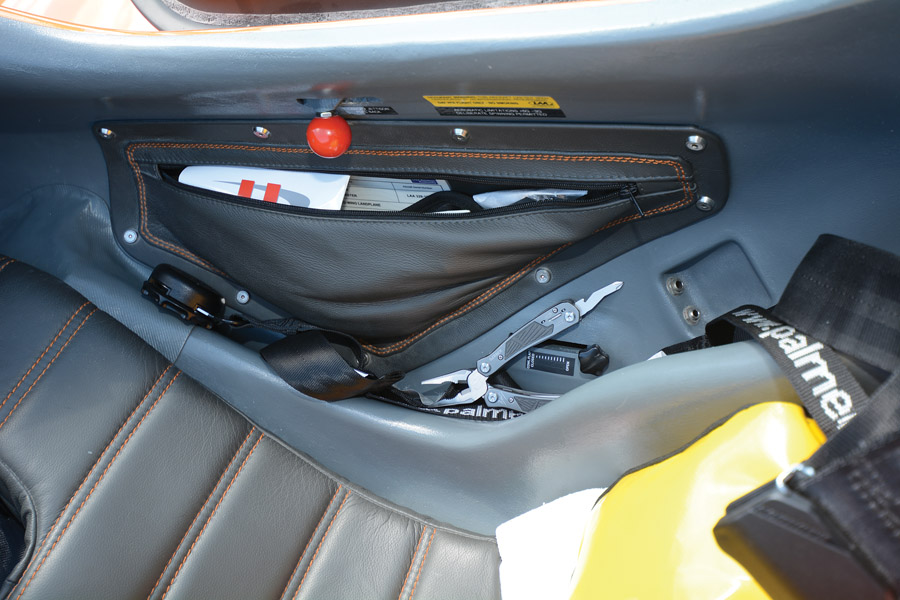
Storage is what’s going on to the right in the cockpit. The pliers handle partially covers the cowl flap control, the red knob is the canopy latch, and the headset jacks are self-evident at the lower right.
Andy’s engine choice was based on the experience of the U.K. Silence Twister agent; he operates a two-ship Twister aerobatic team. Both planes employ ULPower engines and have run well during several thousand hours of hard aerobatic flying, says Andy.
There was one downside: Andy didn’t like the cowling on the agent’s Twisters, so he made his own. Amazingly, but almost predictably, this added a year to the build and likely more weight, but Andy believes his cools the oil better. The oil cooler is remote mounted and has a cowl door. It’s worked “very well” in extreme temperatures, from 86 F (30 C) in Michigan to -4 F (-20 C) cruising over Greenland. “The oil temps stay right in the green.”
Before the cowling could be made, Andy fabbed up cooling plenums for the ULPower engine. Thus, he had the firewall forward absolutely complete, then built the cooling plenums, and finally the cowling. The latter was made in the usual tedious way by wrapping the engine in plastic, cardboard, and foam, followed by hours of cutting, rasping, and sanding to get the shape he wanted.
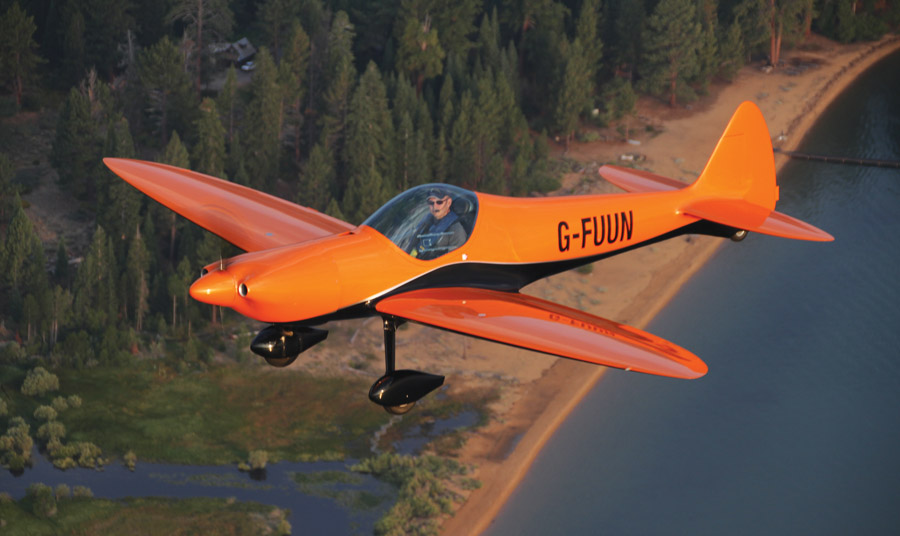
If you remember the Silence Twister as a retractable gear airplane, it’s probably because we showed that option in our 2005 coverage of the type. The powder blue Twister based in Florida and also seen at AirVenture last year is a retract as well. But the fixed gear version is lighter and a touch faster, so folding the feet is pretty much an aesthetic decision.
Once the foam was shaped, it was slathered in micro and resin, and after curing, that was sanded glass smooth. Months of priming and sanding followed, then this male shape was waxed as a releasing agent and the female mold laid up over it. After “praying to the releasing gods that it will release,” Andy pulled off the first half mold—he built the cowling as two pieces—then did the other side. Once the two mold halves were finished, he built the cowling inside it.
Extra fuel was a given in Andy’s build thanks to his wanderlust. The stock tanks are twin 9-gallon wing units; Andy added a 6+ gallon auxiliary tank in the headrest. That tank is actually a transfer tank only, as it drains into the left wing tank. This means the CG issues are compounded as the left wing tank is forward of the CG, yet it must be burned first to accept the headrest tank’s contents. “It gets worse before it gets better,” notes Andy, who goes on to say that yes, the CG is definitely aft when loaded for long legs, but it’s something he can handle as a pilot.
As for overall weight, Andy candidly says he has no idea exactly how heavy over the stated max gross he’s loaded his Twister, but thinks it might have been 286 pounds (130 kilograms). “But as long as the CG is reasonably OK, I’ll accept a reduced rate of climb, and induced drag is only 5 percent of drag, anyway.”
Fuel consumption by the ULPower 4-banger is just 4 gph—15 lph in Andy’s metric terms. This is at 2750 rpm and 125 knots TAS, cruising anywhere between 6000-8000 feet. That yields an endurance of 6.5 hours, and as the longest leg of the trans-Atlantic route is 540 nautical miles and took just 4 hours and 5 minutes, Andy was assured a fairly generous fuel reserve.
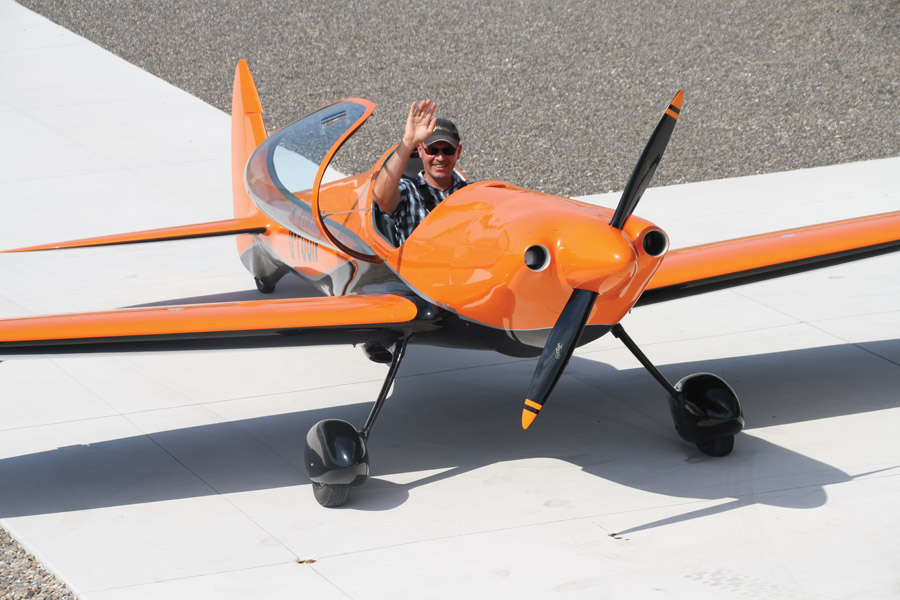
Charmingly speaking English, Andy says his Hercules propeller “has a clever urethane leading edge; you can hit it with an axe” and not hurt it. “But there is a touch of rain damage, more cosmetic than anything else.” The all-wood airscrew measures 58×53 inches for a good compromise between cruise and aerobatic performance and was bought new during a mid-winter doldrums sale for “1100 quid…not crazy expensive.”
The Flight
Once his Twister was licensed and flying in 2016, Andy’s first go was pottering through a local aerobatic contest. But the AirVenture pilgrimage had always been a goal, which Andy began with rather involved research. “I did a lot of reading ferry pilot’s stuff.” Andy was determined to learn all he could about the trans-Atlantic job and where it could go wrong.
What he found was flying from Scotland to Iceland to Greenland, across the Greenland ice cap, and on to Canada does not involve immensely long legs. Yes, much of it is across forbidding water or ice, and there is an 800-mile span at one point, but it is a path routinely traveled by light aircraft, so there is a well-developed course to follow and considerable experience to tap.
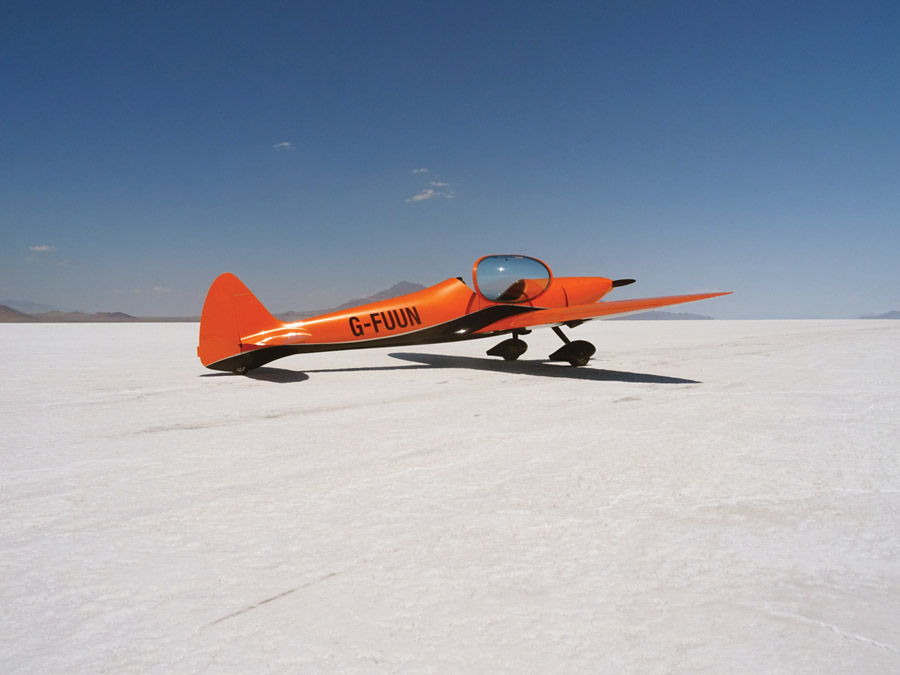
As any motorsports fan/pilot would want to do, Andy landed at the Bonneville Salt Flats to commune with the eerie spirit of the place. But the windless, 104 F (40 C), sun-reflecting environment made this a less than five minute stop. Andy noted the surface wasn’t quite as smooth as he’d thought; something for winter rains to put right.
The dangerous challenge is the weather, even in summer. North Atlantic weather is often horrible for considerable stretches, and good weather can go bad seemingly instantly. Andy concluded having no time constraints was the largest safety factor he could control. He’d simply wait for large patches of good weather.
Andy’s strongest argument was the record of ferry pilots. “One in 300 ends up dying. But, bear in mind, they fly in the winter, and they fly tight schedules because it costs money. But I had a whole month to do it during the best part of the year—late June, early July. They are also flying aircraft they don’t know,” and some of those planes are old, so the equipment can be sketchy. Andy believes, “What they are doing is vastly more dangerous than what I was doing. I know every part of my airplane intimately, and I was giving myself time.”
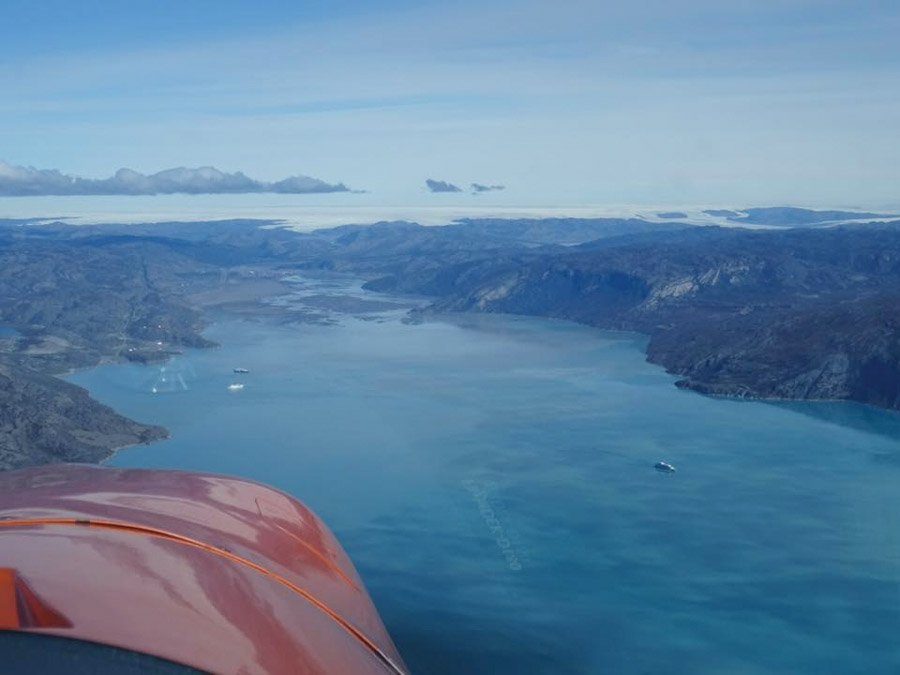
Looking relatively densely populated with three cruise ships and a town, Kangerlussauq, Greenland, beckons during Andy’s return crossing. The daunting Greenland ice cap waits in the distance; next stop Kulusuk on Greenland’s east coast.
Ultimately, flying the Atlantic “was never a suicide mission…Of course, there is an element of risk, but I thought it was worth it. At the end of the day, it’s the weather. You must have the utmost respect for the weather. I’m not going to be a ferry pilot…even if I missed Oshkosh [it would have been worth the trip].”
As it turned out, Andy enjoyed excellent weather last summer for his northern passages, at least until the return leg over Greenland, when he needed to put his instrument skills to use. Standouts were flying into Kulusuk, where there were icebergs and fog banks to dodge on final approach, and crossing the Greenland ice cap.
Even the choice of crossing the ice cap is controversial. “Most people don’t do that; they go south and around Greenland, just fly down the coast. I don’t know why they do that; they are exposing themselves to more coastal fog and glaciers, and they don’t have any alternative…[there is] some naivet there. This was the most stressful and tiring [leg], and one of the shortest legs, too. If you had an autopilot, that would have taken out 90 percent of it, but with no autopilot [you just get on with it].”
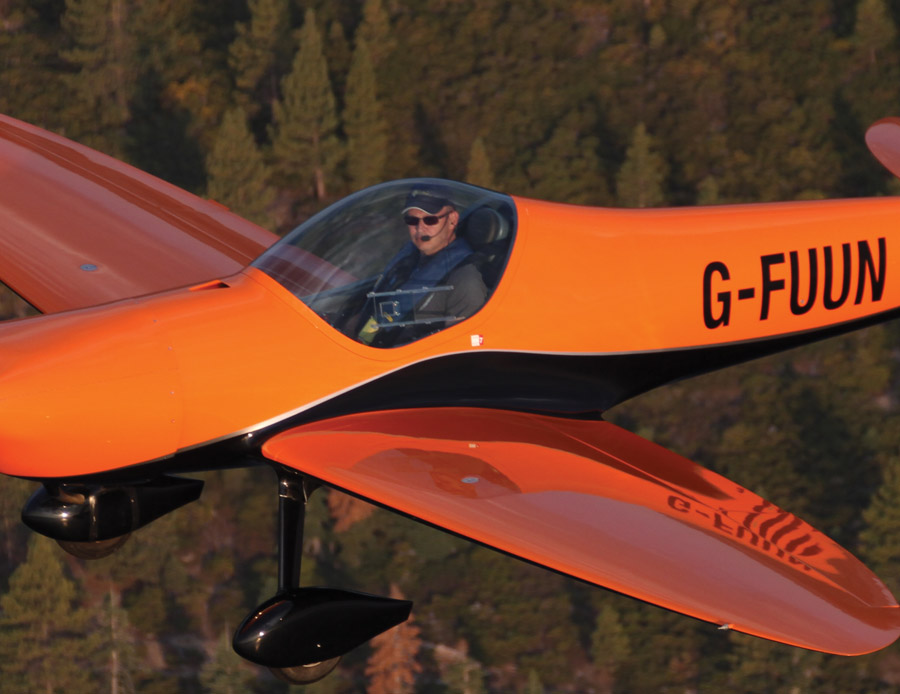
Andy credits his Twister’s inherent honeycomb and Kevlar insulation for keeping him warm over Greenland despite an OAT of -4 F (-20 C) and no cockpit heater—at least while the sun was out. Certainly helping were his immersion suit and greenhouse effect of the bubble greenhouse canopy. Andy did get chilled on the return flight over Greenland when the sun was behind a high cirrus layer, but still stayed warm, considering.
The westbound ice cap crossing was a definite mixed bag. There were clear skies and a tailwind, and thus it was just a three-hour flight, but “by far the most exhausting flying I’ve ever done. It was a whiteout with no sense of height. There is no detail, just bright white. You have no idea of how high you are…you are told how high to fly. Even so, with no visual reference, you can’t see. Normally you aim at something, but there is nothing to aim at in the whiteout.
“I ended up just looking at the heading on the EFIS. The sun is beating down, and I was [constantly] holding my hand up to avoid sunburn. It was getting hot in there.” Andy demonstrated shading his eyes with one hand with his head bent uncomfortably down to avoid the sun and glare—very uncomfortable.
All the while, “Fuel was burning out the front tank, so the CG was getting worse and worse, getting aft all the time. It was as if balancing a pencil on your finger for three hours…I was shattered after it all.” Andy was on oxygen, “which helps, but it isn’t fresh air. It’s not a stable aircraft anyway; it wants to depart and have fun in the sky, and here we are boring along.”
Like Jerrie Mock before him, even without a pressing schedule, Andy did feel the tug of time whenever the weather was good during the crossings. “You want to meet the people and sightsee, but if the weather is good, you go fly.”
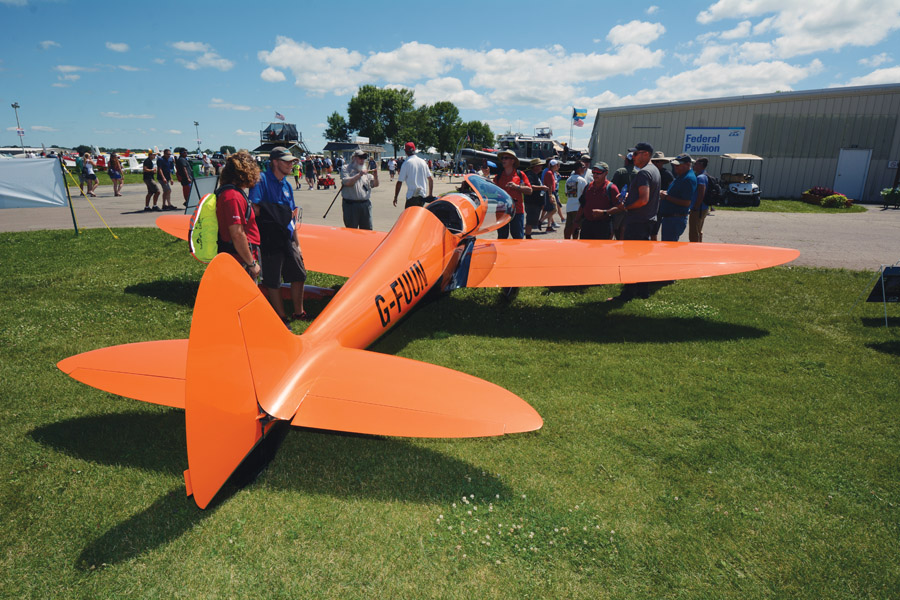
Despite its diminutive size, Andy’s tangerine Twister drew a steady flow of the curious at AirVenture. He said everyone asked the same five questions—How fast? How far? etc.—and he patiently answered them all. Two things stand out when seeing this Twister in the composite: it sits surprisingly low to the ground, and the Great Britain G-FUUN registration didn’t get there by accident.
Having time to meet people wasn’t an issue when Andy made Canada. While talking to customs officers, the wind lifted his Twister’s unlatched canopy and banged it over center. This stressed the hinges and ripped out the securing cable. Hospitable Canadians on the field immediately helped fix the wounded canopy. “It was resin and flock that had been hurt,” so the repairs weren’t extensive, but still there were four days waiting for the resin to harden. “We did the hinges first, then the securing cable on two separate days, and one day waiting for weather.”
In Andy’s thinking, just as dangerous as crossing the Atlantic was traversing much of Canada. “It was flying for hours and hours…there is no sign man has been there. Yeah, unreal. And the trees! There’s nothing but trees or water. History says stalling in the trees is better than going in the water. You’ll smash the airplane up either way, but I think it would float; the honeycomb would help, lots of trapped air. I don’t want to find out! I have enough firsts already; I don’t want to know if they float, either.”
During our AirVenture interview, Andy was anticipating Mt. Rushmore, Devil’s Peak, and the Bonneville Salt Flats, plus visiting the first Twister builder in Seattle. And he did all those things, including landing on the Salt Flats and seeing where the cars run for speed. “…actually landing on the speed run. You could see the tire marks where they wore it down. The surface was a little bumpy, not concrete smooth; that kind of surprised me. There was no wind at all, completely still and must have been pushing 104 F (40 C). Flipping hot! Didn’t stay still for long.” Then it was off to Reno, Nevada, Northern California, Seattle to visit with the first Twister builder in North America, then across Canada, and ultimately retracing his flight across the North Atlantic and home at Little Gransden Airfield, South Cambridgeshire, U.K.
Andy reinforced his belief in careful research before such an epic flight, especially the latest experiences. “Much of the info out there is 15 years old, so it’s best to get the latest thinking and pass it along to others via the blog or whatever.”
Somehow, we don’t think we’ve heard the last of Andy McKee or his Silence Twister.

